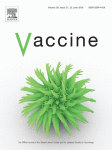View Item
- xmlui.general.dspace_homeCentros e Institutos de InvestigaciónCICVyA. Centro de Investigación en Ciencias Veterinarias y AgronómicasInstituto de PatobiologíaArtículos científicosxmlui.ArtifactBrowser.ItemViewer.trail
- DSpace Home
- Centros e Institutos de Investigación
- CICVyA. Centro de Investigación en Ciencias Veterinarias y Agronómicas
- Instituto de Patobiología
- Artículos científicos
- View Item
Evaluation of the safety profile of the vaccine candidate Brucella melitensis 16MDvjbR strain in goats
Abstract
Small ruminant brucellosis is caused by the Gram negative cocci-bacillus Brucella (B.) melitensis, the most virulent Brucella species for humans. In goats and sheep, middle to late-term gestation abortion, stillbirths and the delivery of weak infected offspring are the characteristic clinical signs of the disease. Vaccination with the currently available Rev. 1 vaccine is the best option to prevent and control the disease, although it is far from ideal.
[ver mas...]
Small ruminant brucellosis is caused by the Gram negative cocci-bacillus Brucella (B.) melitensis, the most virulent Brucella species for humans. In goats and sheep, middle to late-term gestation abortion, stillbirths and the delivery of weak infected offspring are the characteristic clinical signs of the disease. Vaccination with the currently available Rev. 1 vaccine is the best option to prevent and control the disease, although it is far from ideal. In this study, we investigate the safety of the B. melitensis 16MΔvjbR strain during a 15-month period beginning at vaccination of young goats, impregnation, delivery and lactation. Forty, 4 to 6 months old, healthy female crossbreed goats were randomly divided into four groups (n = 10) and immunized subcutaneously with a single vaccine dose containing 1x109 CFU of B. melitensis 16MΔvjbR delivered in alginate microcapsules or non-encapsulated. Controls received empty capsules or the commercially available Rev.1 vaccine. Seven months post-vaccination, when animals were sexually mature, all goats were naturally bred using brucellosis-free males, and allowed to carry pregnancies to term. Blood samples to assess the humoral immune response were collected throughout the study. At two months post-delivery, all dams and their offspring were euthanized and a necropsy was performed to collect samples for bacteriology and histology. Interestingly, none of the animals that received the vaccine candidate regardless of the formulation exhibited any clinical signs associated with vaccination nor shed the vaccine strain through saliva, vagina or the milk. Gross and histopathologic changes in all nannies and offspring were unremarkable with no evidence of tissue colonization or vertical transmission to fetuses. Altogether, these data demonstrate that vaccination with the mutant strain 16MΔvjbR is safe for use in the non-pregnant primary host.
[Cerrar]

Author
Castaño Zubieta, Mirta Raquel;
Rossetti, Carlos Alberto;
Garcia-Gonzalez, Daniel G.;
Maurizio, Estefanía;
Hensel, Martha E.;
Rice-Ficht, Allison C.;
Ficht, Thomas A.;
Arenas-Gamboa, Angela M.;
Fuente
Vaccine 39 (3) : 617-625 (Enero 2021)
Date
2021-01
Editorial
Elsevier
ISSN
0264-410X
Documentos Relacionados
Formato
pdf
Tipo de documento
artículo
Proyectos
(ver más)
INTA/PNSA-1115052/AR./Epidemiología y desarrollo de estrategias para la prevención y control de enfermedades que afectan la salud pública, enfermedades exóticas y limitantes del comercio internacional.
Palabras Claves
Derechos de acceso
Restringido
 Excepto donde se diga explicitamente, este item se publica bajo la siguiente descripción: Creative Commons Attribution-NonCommercial-ShareAlike 2.5 Unported (CC BY-NC-SA 2.5)
Excepto donde se diga explicitamente, este item se publica bajo la siguiente descripción: Creative Commons Attribution-NonCommercial-ShareAlike 2.5 Unported (CC BY-NC-SA 2.5)

